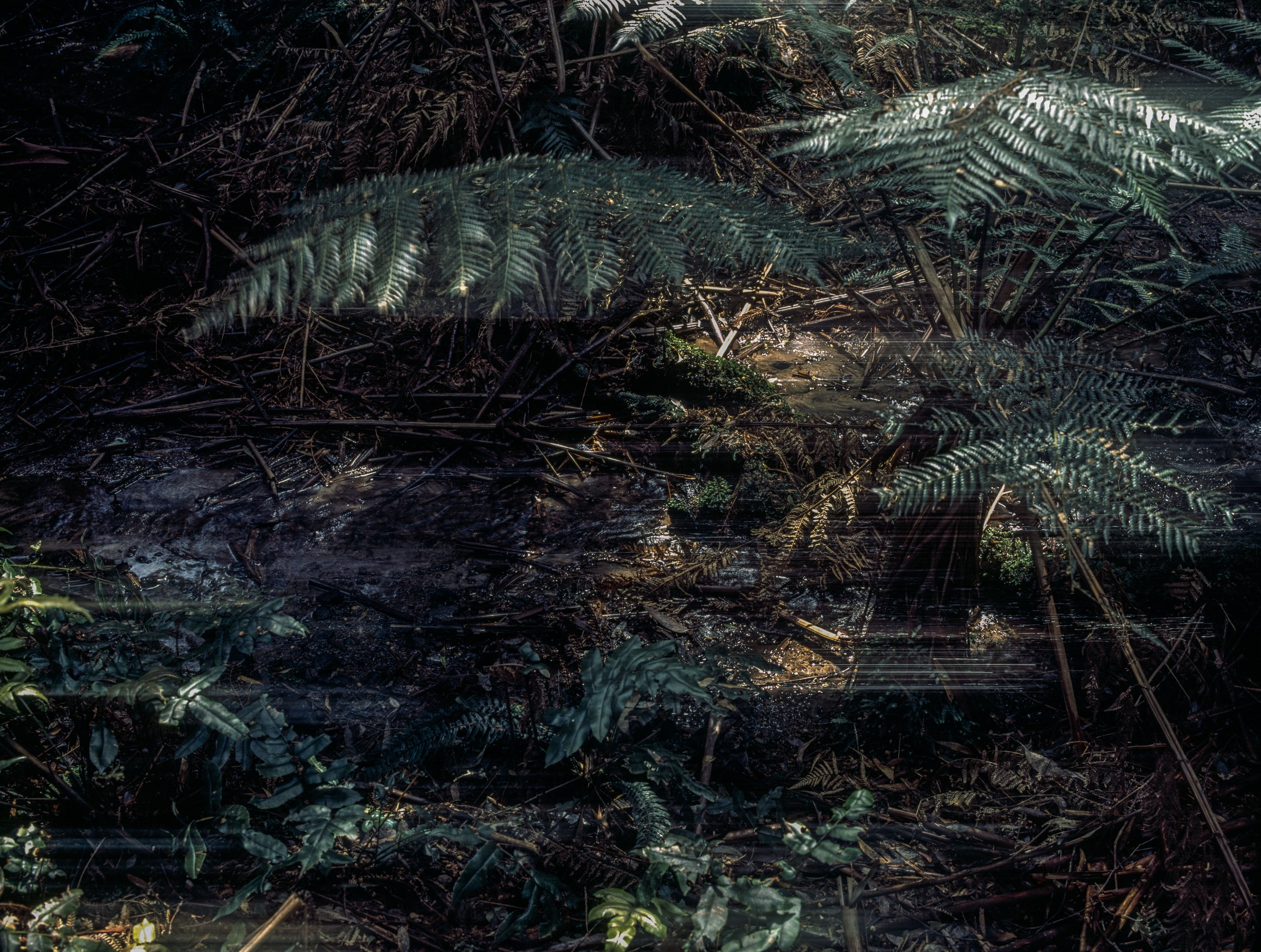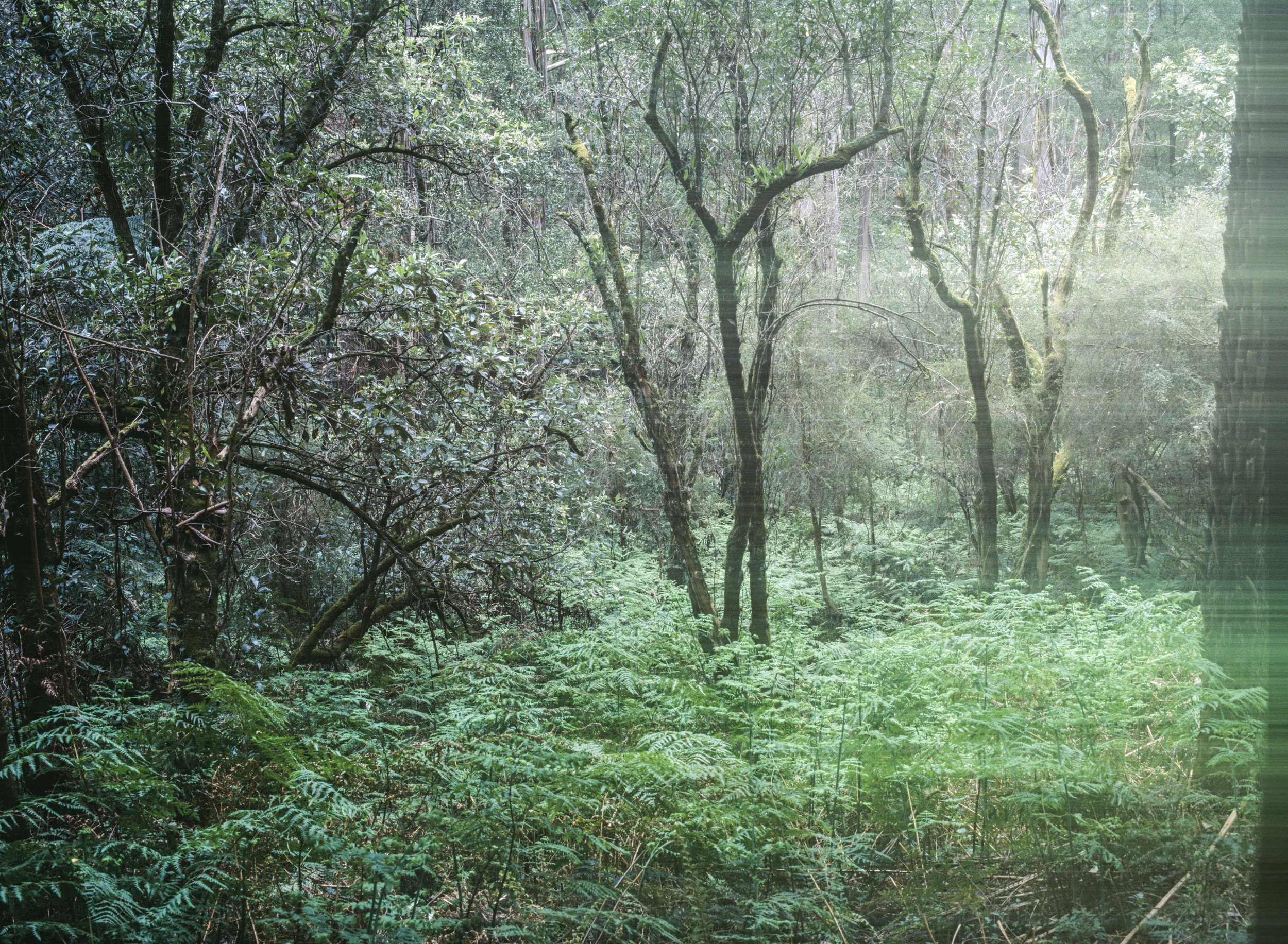
What is your work about & what medium do you use?
Photography, moving image, sound, and generative imagery from deep learning artificial intelligence.
Strict interpretations of photography favour the ‘perfect’ image. Leaning toward my conceptual underpinnings, my works aesthetically degrade the image to create material that engages with the inconsistencies in both perception and reality.
My work utilises distorted and manipulated imagery to break down habituated responses to reality and uncover alternative iterations of our experience. Experiences can diverge from the reality that “may exist”. Evolutionary neuroscience teaches us that we have as a species, evolved our perception and thus components of our reality. However, this development takes place alongside our evolution and needs as a species and there are many divergent experiences of reality both within and without of our species that we cannot easily access.
In my most recent series Biome, I used film and photography to create ethereal streaks of light across landscape photographs. These were taken in the Dandenong Ranges, a temperate rainforest biotic community. The technique in essence, made light “visible”. There is an illusion to photonic structure of light, as the physicality of its presence creates a number of visible planes.
The light is flat on the image, appearing on first glance to be overlayed, but originates from points that are in the background, middle ground and foreground. This then distorts traditional readings of depth. In moving image depictions, I layered both frames before, and after the immediate frame, to create ghostly and blurred renditions that worked especially well with objects in motion. I created three video pieces using this piece, titled Wind, Water, and Rain. This merging of motion from the past, present, and future (from the standpoint of a single frame), weighs metaphysical presuppositions on time, space, and reality.
I have also begun to draw into the realm of speculative landscapes, using my own imagery to produce a synthesised reality in cooperation with artificial intelligence. These speculative landscapes expand on thinking to realise the most important concerns of humanity currently, climate action and space travel. In utilising artificial intelligence and deep learning, I input thousands of source images from my own shoots, that display a diversity of imagery for the AI to learn from. From there, the machine learning produces approximates that are alien, kaleidoscopic, and not adherent to Earth bound rules of nature. Biome is a research project into the nexus of perception, reality, cognition, space, and time, seeks to speculate on the future based on the present, in essence, serving as a reminder of the preciousness of what we know to be propelled into the unknown.

How did your project come to be?
The project has developed from a founding conceptual underpinning from early on in 2021 (with inspiration taken from 2020), to be aesthetically evolved throughout the year.
Most of my work uses the natural environment as a catalyst for deeper thinking into elements of metaphysics. However, it took form in a very different direction earlier this year.
I shot with a focus to produce hyper realistic and detail-oriented photographs, that would be the visual opposite to the types of work I produce now. These images appear so real that they often look computer rendered, and not entirely present in reality. To me, producing images of an overly realistic quality, did translate into the ideas and conceptual focus of the works, however, did so slowly and required volumes that were inconceivable to produce by my deadlines.
These images were nonetheless important to the foundation of the work, the direction it took, and were also inputted as the data sets from which artificial intelligence learnt. I still love this kind of work and produce them regularly as a subset of projects. Perhaps there will be a place for them in future iterations of Biome.
I have a medium format camera that I discovered a technique that could produce the streaks of light across the image. This immediately changed the direction for the bulk of the year, and with under six weeks to complete the body of work by the deadline date.
From here, I developed dozens of individual works: seventy-five video clips each about a minute to two minutes long, photogrammetric scans taken with a lidar, sound pieces, time-lapse pieces, about one hundred medium format studies for the Field Journal, and multiple pieces with generative adversarial network artificial intelligence programs.
How has your practice changed over time?
My practice is in its early days, but the mental clarity and focus spurred from isolation, created a cocoon in which I could hone my skills and strengthen my research. I was fortunate to have the resilience to not allow isolation to hinder my progression, but as a zone in which to quietly focus with the development of my work and studies.
Earlier this year, I participated in a workshop that taught me the skills of photogravure. Photogravure is an alternative presentation method that blends photography with intaglio printmaking processes. It was where the mass production of the photographic image began in the late 19th and into the 20th century. In fact, the Field Journal component of Biome, a section-sewn 188 page book, took inspiration from a series of giant photogravure catalogues produced by renowned early 20th century photographer Edward S. Curtis. Curtis meticulously photographed thousands of cultural artefacts, peoples, practices, habitats, and landscapes in his renowned The North American Indian. This document still serves as an invaluable insight into First Nations across the United States, where turn of the century industrialisation and the philosophical belief of ‘manifest destiny’, supplanting previously existing Nations and peoples.
What I sought to echo from Curtis, in the production of the Field Journal was a detailed documentation of the temperate rainforest biotic community. To pull it apart and reassemble it in a variety of formats, enclosed within the book. I’ve long been curious to explore web- based experiences for arts to democratise its accessibility and push engagement and interactivity with the works into an individualised experience. Field Journal enables viewers to explore videos and photogrammetric scans taken with a lidar, all from their mobile device after scanning their phone over encoded images and QR codes within the book. The book becomes more than just a selection of still images shot on my medium format camera but exists in a liminal space in between the digital and the real world. This dimensional twist also sat comfortably into the fundamental research behind the work, where reality exists outside of our singular experience of it. Basically, I’ve in this year alone I’ve come from a desire to explore an ‘analogue’ process of photographic reproduction that began development in the 1820’s, and landed into processes that are evolving now, two hundred years later.
It's changing quickly, the ideas come ahead of the realisations, naturally, but there’s a coherency that I am still developing to connect the dots and fill all the pieces together into a final form.

Is there an emotional connection to the work you would like to share?
I think I came from a few places when approaching the work. Personally, it wasn’t an emotionally entrenched operation. There is more of a connection to the universe that I think we need to understand a lot deeper. Perhaps as my work exists at a time where environmental action and climate change response is a daily reality, this could be my response to it all. But I am always hesitant to immediately draw a direct link to contemporary events. This may sound oxymoronic underneath the thematic of my practice, it is just important to not assign causality to the work, as it’s not just about the climate or environment, but also about our condition, how we physically see, how these biotic communities cooperate as a macroorganism, or how an image becomes space.

Where can the viewer see more of your work and what is next for you?
My work is archived on my website, forrestbeasley-birch.com and I maintain an Instagram account @forrest.beasleybirch.
Sound is a new direction; I have hours of underutilised recordings taken in the Dandenong Ranges. I want to start producing longer sound scapes with artificial intelligence and see what comes out of this process.
More lidar scanning with a photogrammetric output, to produce giant rendered scans of natural environments. Either to be enclosed within further books, or as spaces within installations.
Travel, I want to extend what I have done in Biome to other environments. Polar, tundra, savanna, desert, tropical rainforests, you name it, I’ll be there.
Pushing the speculative landscape ideas in my earlier works, to create resolved pieces that immerse viewers deeper into off-world environments.








